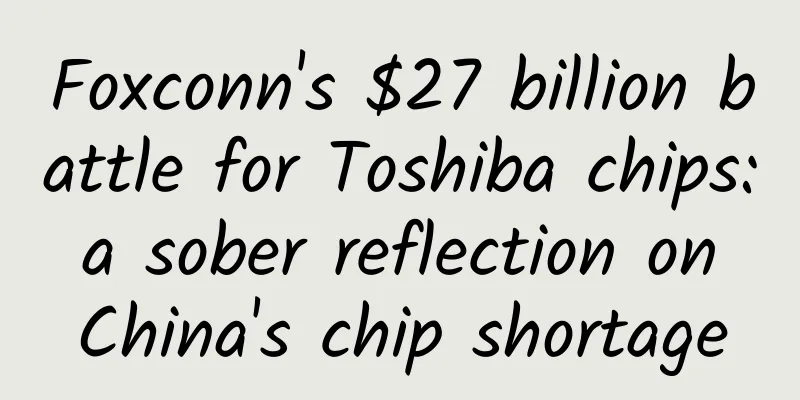Foxconn's $27 billion battle for Toshiba chips: a sober reflection on China's chip shortage

|
It's time to go shopping! After Nokia and Sharp, Foxconn's Terry Gou is planning another big acquisition. The latest news shows that Taiwan's Foxconn has told Toshiba that it is ready to acquire Toshiba's computer chip business for up to $27 billion. This is another acquisition attempt by Foxconn to acquire a top Japanese high-tech company. It is said that the reserve price is 8.8 billion US dollars, some buyers believe that they will only bid up to 13.5 billion US dollars, and other buyers offer up to 18 billion US dollars, while Foxconn offers a sky-high price of 27 billion US dollars. Toshiba sinks Toshiba is actually very familiar to everyone. Toshiba is Japan's largest semiconductor manufacturer and the second largest integrated motor manufacturer, affiliated to the Mitsui Group. However, Toshiba has suffered a series of misfortunes in recent years. The 2015 financial report was fraudulent; In 2016, the company was caught in a crisis of write-downs in its nuclear power business, with its U.S. nuclear power plant business recording billions of dollars in losses. In order to avoid delisting of its shares, Toshiba was forced to sell its most profitable chip assets to raise funds for self-rescue. Is this little thing so valuable? The latest news is that Foxconn is willing to acquire Toshiba's chip business with a maximum price of US$270. Some people may ask, why is the chip business so valuable? Chips are Toshiba's most profitable division, accounting for only 15% of total revenue but contributing more than half of the profits.
Buy, buy, buy! Terry Gou's history of Foxconn acquisitions Everyone should be familiar with Foxconn, a world-renowned OEM factory that serves brands including Xiaomi, Huawei, Apple, etc. The growth history of Foxconn can be described as a bloody history of a "OEM" empire. However, judging from Foxconn’s series of acquisitions in recent years, it is clear that Terry Gou is about to start a series of transformations and planning for this century-old company. In May 2016, FIH Mobile, a subsidiary of Foxconn, announced that it had acquired the manufacturing rights for Nokia-branded feature phones for US$350 million. In August of the same year, Foxconn invested 388.8 billion yen (about US$3.8 billion) in Sharp to acquire a 66% stake in it. Foxconn and Sharp are preparing to invest heavily in the LCD panel business and build large-scale LCD TV panel factories in the mainland. … Obviously, in the past few years, a generation of "OEM empire" has been desperately transforming. Purpose—“Unite with Japan to resist South Korea”? From historical experience, Japan and South Korea have both used memory chips (DRAM and NAND Flash) as a breakthrough point to become major semiconductor powers. In the 1970s, Toshiba, NEC and Hitachi snatched the memory market from the United States and once occupied the top three positions among global semiconductor companies. However, as Japan's electronics industry weakened, South Korea's chip industry took the opportunity to rise.
Foxconn's acquisition of Toshiba's chip business was interpreted by the market as "joining forces with Japan to fight against South Korea" and challenging Samsung's leading position in NAND flash memory. "The pain of chip shortage" - the road to localization of chips is difficult my country has always been the country with the largest trade deficit in the global integrated circuit field, with annual imports exceeding US$200 billion, far exceeding the amount of oil imports, and the domestic production rate is less than 10%. Ye Tianchun, director of the Institute of Microelectronics of the Chinese Academy of Sciences, once said: "In the next 30 years, if we do not solve the problem of chip manufacturing ourselves, the so-called information age will lose a very important support and foundation." Obviously, our country has long been aware of the importance of chips to national and industrial security. Not only has a large integrated circuit industry fund of hundreds of billions been established, but domestic capital has also long begun the road of overseas mergers and acquisitions. According to incomplete statistics, since 2013, Chinese companies and capital, mainly Jianguang Capital, Wuyuefeng Capital, Tsinghua Unigroup, have invested US$15 billion overseas and completed 10 international mergers and acquisitions. However, we must be particularly clear that we cannot buy foreign core technologies through acquisitions alone. It is undeniable that acquisitions have greatly promoted China's chip industry, but it should be noted that the core technology of chips is still in the hands of American companies such as Intel, Qualcomm, IBM, and AMD. Tsinghua Unigroup offered $23 billion to acquire U.S. chipmaker Micron Technology in 2015, but failed to do so for various reasons. This is a good example of simply hoping to acquire core technology through acquisition. Fortunately, in order to break the pain of chip shortage, with the help of the national industrial fund, many places in China have begun to invest heavily in the field of memory chip research and development and production. No matter how long the process is, the goal of making "chips" remains unchanged. As a winner of Toutiao's Qingyun Plan and Baijiahao's Bai+ Plan, the 2019 Baidu Digital Author of the Year, the Baijiahao's Most Popular Author in the Technology Field, the 2019 Sogou Technology and Culture Author, and the 2021 Baijiahao Quarterly Influential Creator, he has won many awards, including the 2013 Sohu Best Industry Media Person, the 2015 China New Media Entrepreneurship Competition Beijing Third Place, the 2015 Guangmang Experience Award, the 2015 China New Media Entrepreneurship Competition Finals Third Place, and the 2018 Baidu Dynamic Annual Powerful Celebrity. |
<<: Faraday Future says it has not yet raised $1 billion in "life-saving money"
Recommend
With no money and no resources, how did Keep gain 60 million users through “dirty work”?
As a post-90s campus entrepreneur with no resourc...
Mid-Autumn Festival is coming. How can children eat mooncakes to satisfy their cravings and stay healthy? Here is the most comprehensive guide!
Mid-Autumn Festival is a traditional festival in ...
New Media Operations: 5 Tips for 100,000+ Hot Articles
A 10W+ viral article can be produced accidentally...
Does using BT to download damage your SSD?
Q: Will BT and other P2P download methods reduce t...
Out of the pouch ≠ born! Kangaroo "daughter" actually "fought" with her mother?
Do you think that once the baby kangaroo shows it...
Security researchers discover Apple Bluetooth bug that can remotely wipe nearby iPhones/iPads
On October 14, as we all know, Apple's operat...
Xiaoheilong Volume Price School, Volume Column, Volume Line Technology Video Course
Xiaoheilong Volume Price School, Volume Column, V...
Apple reverses its attitude, Launcher returns to App Store
Compared with previous versions of the operating ...
Internet TV: Industry observations after interviewing license holders
According to Streaming Media Network: On July 11 ...
World Mosquito Day丨Do mosquitoes also have to "take turns"? Let's take a look at the mosquito work schedule
Produced by: Science Popularization China Author:...
The Tibetan macaques in Nangqian, Qinghai are popular. Why don't you come and see them?
Recently, Xinhua News Agency published an article...
Scarabaeidae: When you’re hungry, eat a “house”!
In the forest, on a green leaf, an insect is busy...
WeChat 8.0 can also be used like this! Tips for setting status in WeChat 8.0
[[379441]] In the past two days, WeChat 8.0 has b...
I am a tomb keeper in Xinzheng
An anti-tomb-robbing novel that makes your blood b...
How much does it cost to make a wine utensils mini program in Bayanzhuoer?
There is no doubt that the topic of mini programs...









